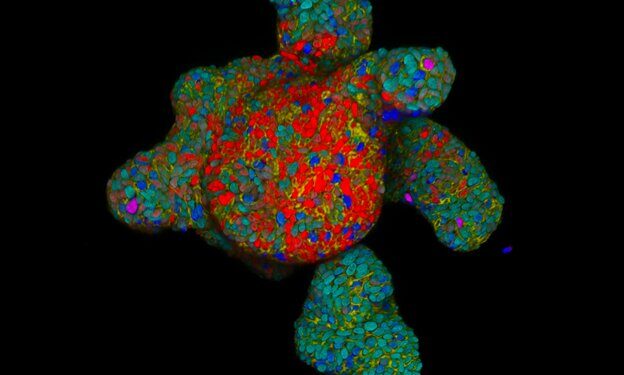A human intestinal organoid, exhibiting typical “budding crypts” and a central “villi-like” domain. The main types of intestinal cells are shown in green, blue, red and purple. The membranes are yellow and the nuclei cyan. Credit: Ninouk Akkerman, Yannik Bollen and Jannika Finger, Institute of Human Biology
A multi-institutional group of researchers led by the Hubrecht Institute and the Roche Institute of Human Biology has developed strategies to identify regulators of intestinal hormone secretion. In response to the food received, these hormones are secreted by rare hormone-producing cells in the intestine and play a key role in managing digestion and appetite.
The team developed new tools to identify possible “nutrient sensors” on these hormone-producing cells and study their function. This could lead to new strategies to interfere with the release of these hormones and pave the way for the treatment of various disorders of metabolism or intestinal motility. The work was featured in an article in Science on October 18.
The intestine acts as a vital barrier. It protects the body from harmful bacteria and highly dynamic pH levels, while allowing nutrients and vitamins to enter the bloodstream. The intestine is also home to endocrine cells, which secrete many hormones that regulate bodily functions.
These enteroendocrine cells (EECs, intestinal endocrine cells) are very rare cells that release hormones in response to various triggers, such as stretching of the stomach, energy levels, and nutrients in food .
These hormones in turn regulate key aspects of physiology in response to incoming food, such as digestion and appetite. Thus, EECs are the body’s first responders to incoming food, and instruct and prepare the rest of the body for what is coming.
Drugs that mimic gut hormones, including GLP-1, hold great promise for treating multiple metabolic diseases. Direct manipulation of EECs to adjust hormone secretion could pave the way for new therapeutic options. However, it is difficult to understand how to effectively influence the release of gut hormones.
Researchers have had difficulty identifying EEC sensors because EECs themselves represent less than 1% of cells in the intestinal epithelium, and furthermore, EEC sensors are expressed in low quantities.
Current studies rely primarily on mouse models, although the signals that mouse EECs respond to are likely different from those that human EECs respond to. Therefore, new models and approaches were needed to study these signals.
In this human stomach organoid, you see a rare purple cell producing ghrelin. Credit: Ninouk Akkerman and Mike Nikolaev, Institute of Human Biology
Enteroendocrine cells in organoids
The Hubrecht team has already developed methods to derive large quantities of CEE in human organoids. Organoids contain the same cell types as the organ from which they originated and are therefore useful for exploring the development and function of cells such as EECs. Using a special protein, Neurogenin-3, the researchers were able to generate a high number of EECs.
In the past, Hubrecht researchers developed a way to increase the number of EECs in intestinal organoids. Since EECs have different sensors and hormonal profiles in different regions of the intestine, studying these rare cells requires researchers to make organoids enriched with EECs from all of these different regions.
In the current study, the team successfully enriched EECs in organoids from other parts of the digestive system, including the stomach. Like the true stomach, these stomach organoids respond to known inducers of hormone release and secrete large amounts of the hormone ghrelin, also called the “hunger hormone” because it plays a key role in signaling brain hunger.
This confirms that these organoids can be used to study hormone secretion in EECs.
CEE sensors
As EECs are rare, researchers have had difficulty profiling them. In the current study, the team identified a so-called surface marker, called CD200, on human EECs. Researchers used this surface marker to isolate large numbers of human EECs from organoids and study their sensors.
This revealed many receptor proteins that had not previously been identified in EECs. The team then stimulated the organoids with molecules that would activate these receptors and identified several new sensory receptors that control hormone release. When these receptors were inactivated using CRISPR-based gene editing, hormone secretion was often blocked.
Using this data, researchers can now predict how human EECs respond when certain sensory receptors are activated. Their findings thus pave the way for additional studies to explore the effects of these receptor activations.
The CEE-enriched organoids will allow the team to carry out larger, unbiased studies to identify new regulators of hormone secretion. These studies could eventually lead to therapies for metabolic diseases and intestinal motility disorders.
More information:
Joep Beumer et al, Description and functional validation of human enteroendocrine cell sensors, Science (2024). DOI: 10.1126/science.adl1460. www.science.org/doi/10.1126/science.adl1460
Provided by the Hubrecht Institute
Quote: Scientists develop tools to identify intestinal nutrient sensors (October 17, 2024) retrieved October 17, 2024 from
This document is subject to copyright. Except for fair use for private study or research purposes, no part may be reproduced without written permission. The content is provided for informational purposes only.



